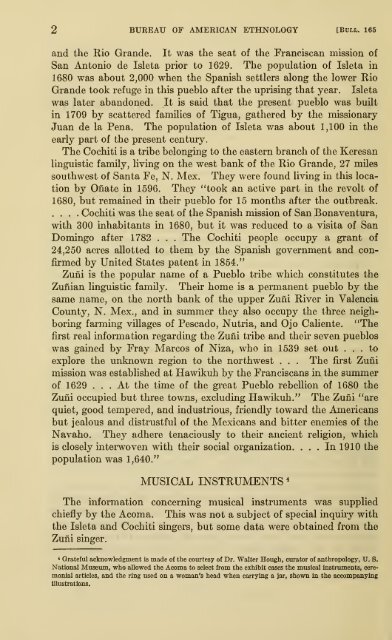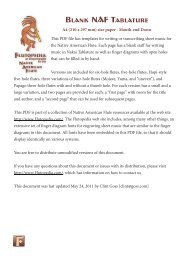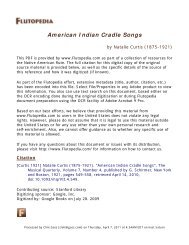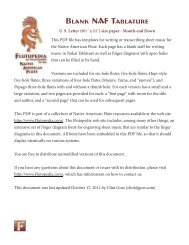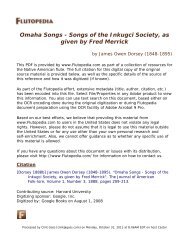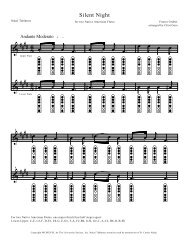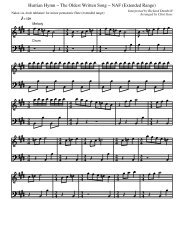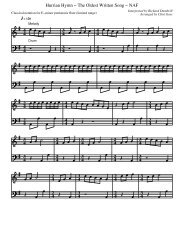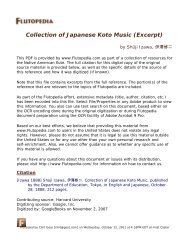Music of Acoma, Isleta, Cochiti, and Zuñi Pueblos - Flutopedia.com
Music of Acoma, Isleta, Cochiti, and Zuñi Pueblos - Flutopedia.com
Music of Acoma, Isleta, Cochiti, and Zuñi Pueblos - Flutopedia.com
Create successful ePaper yourself
Turn your PDF publications into a flip-book with our unique Google optimized e-Paper software.
2 BUREAU OF AMERICAN ETHNOLOGY [Bull. 165<br />
<strong>and</strong> the Rio Gr<strong>and</strong>e. It was the seat <strong>of</strong> the Franciscan mission <strong>of</strong><br />
San Antonio de <strong>Isleta</strong> prior to 1629. The population <strong>of</strong> <strong>Isleta</strong> in<br />
1680 was about 2,000 when the Spanish settlers along the lower Rio<br />
Gr<strong>and</strong>e took refuge in this pueblo after the uprising that year. <strong>Isleta</strong><br />
was later ab<strong>and</strong>oned. It is said that the present pueblo was buUt<br />
in 1709 by scattered families <strong>of</strong> Tigua, gathered by the missionary<br />
Juan de la Pena. The population <strong>of</strong> <strong>Isleta</strong> was about 1,100 in the<br />
early part <strong>of</strong> the present century.<br />
The <strong>Cochiti</strong> is a tribe belonging to the eastern branch <strong>of</strong> the Keresan<br />
linguistic family, living on the west bank <strong>of</strong> the Rio Gr<strong>and</strong>e, 27 miles<br />
southwest <strong>of</strong> Santa Fe, N. Mex. They were found living in this location<br />
by Onate in 1596. They "took an active part in the revolt <strong>of</strong><br />
1680, but remained in their pueblo for 15 months after the outbreak.<br />
.... <strong>Cochiti</strong> was the seat <strong>of</strong> the Spanish mission <strong>of</strong> San Bonaventura,<br />
with 300 inhabitants in 1680, but it was reduced to a visita <strong>of</strong> San<br />
Domingo after 1782 . . . The <strong>Cochiti</strong> people occupy a grant <strong>of</strong><br />
24,250 acres allotted to them by the Spanish government <strong>and</strong> confirmed<br />
by United States patent in 1854."<br />
Zuni is the popular name <strong>of</strong> a Pueblo tribe which constitutes the<br />
Zunian linguistic family. Their home is a permanent pueblo by the<br />
same name, on the north bank <strong>of</strong> the upper Zuni River in Valencia<br />
Coimty, N. Mex,, <strong>and</strong> in summer they also occupy the three neighboring<br />
farming villages <strong>of</strong> Pescado, Nutria, <strong>and</strong> Ojo Caliente. "The<br />
first real information regarding the Zuni tribe <strong>and</strong> their seven pueblos<br />
was gained by Fray Marcos <strong>of</strong> Niza, who in 1539 set out ... to<br />
explore the unknown region to the northwest , . . The first Zuni<br />
mission was established at Hawikuh by the Franciscans in the summer<br />
<strong>of</strong> 1629 ... At the time <strong>of</strong> the great Pueblo rebellion <strong>of</strong> 1680 the<br />
Zuni occupied but three towns, excluding Hawikuh." The Zuni "are<br />
quiet, good tempered, <strong>and</strong> industrious, friendly toward the Americans<br />
but jealous <strong>and</strong> distrustful <strong>of</strong> the Mexicans <strong>and</strong> bitter enemies <strong>of</strong> the<br />
Navaho. They adhere tenaciously to their ancient religion, which<br />
is closely interwoven with their social organization. . . . In 1910 the<br />
population was 1,640."<br />
MUSICAL INSTRUMENTS *<br />
The information concerning musical instruments was supplied<br />
chiefly by the <strong>A<strong>com</strong>a</strong>. This was not a subject <strong>of</strong> special inquiiy with<br />
the <strong>Isleta</strong> <strong>and</strong> <strong>Cochiti</strong> singers, but some data were obtained from the<br />
Zuni singer.<br />
* Grateful acknowledgment is made <strong>of</strong> the courtesy <strong>of</strong> Dr. Walter Hough, curator <strong>of</strong> anthropology, U. S.<br />
National Museum, who allowed the <strong>A<strong>com</strong>a</strong> to select from the exhibit cases the musical instruments, ceremonial<br />
articles, <strong>and</strong> the ring used on a woman's head when carrying a jar, shown In the ac<strong>com</strong>panying<br />
Illustrations.


